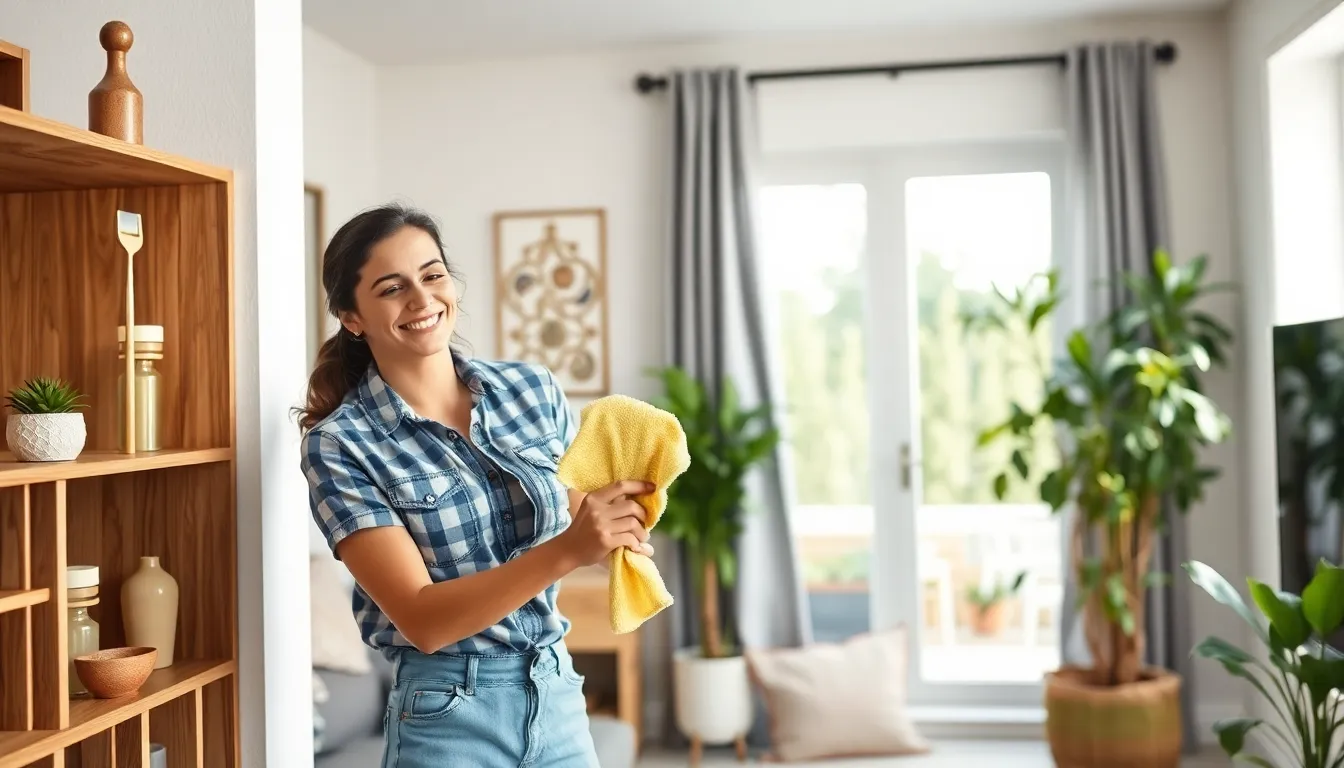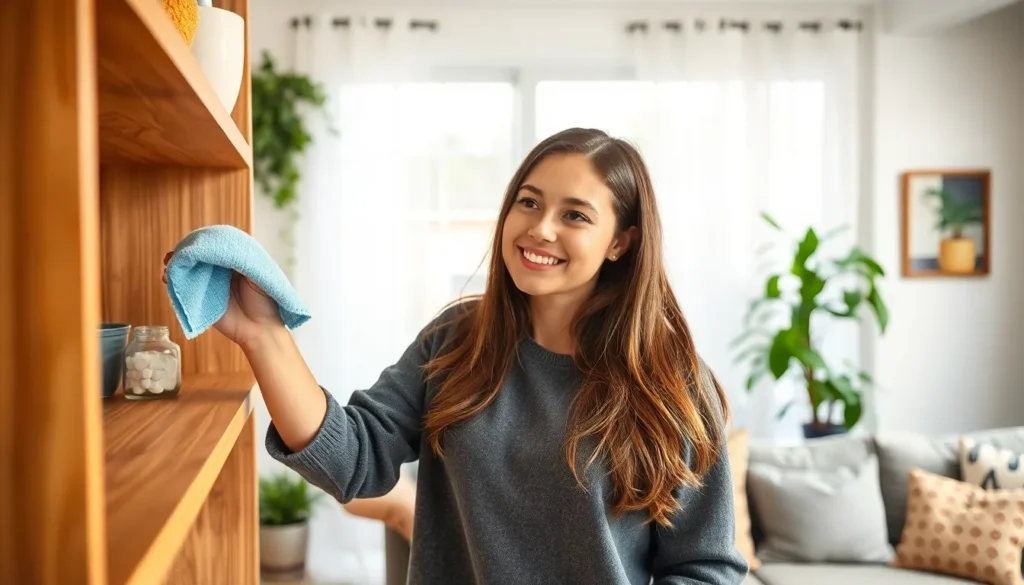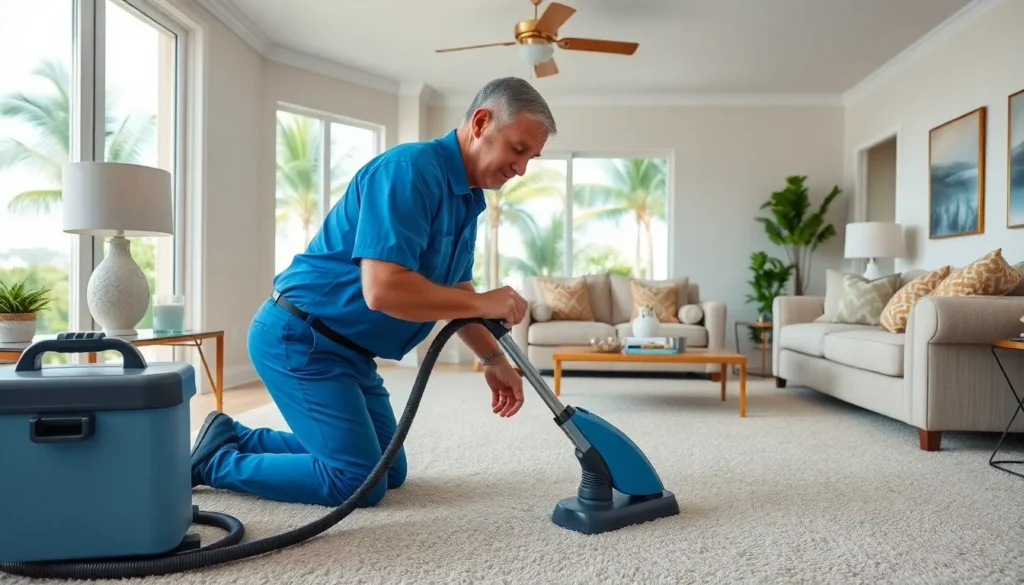Table of Contents
ToggleDusting might seem like the most mundane of chores, but it’s the unsung hero of home maintenance. Picture this: a cozy living room filled with laughter, but lurking in the corners are dust bunnies plotting their takeover. Who knew those fluffy little foes could turn your sanctuary into a sneeze-fest?
But fear not! Dusting isn’t just about banishing those pesky particles; it’s about reclaiming your space and enjoying a healthier environment. With a few clever tips and tricks, anyone can transform dusting from a dreaded task into a satisfying ritual. So grab your trusty duster and get ready to conquer the dust—because a clean home is a happy home, and who wouldn’t want that?
Understanding Dusting
Dusting involves removing dust particles from surfaces in a home. Regular dusting prevents buildup and enhances air quality.
What Is Dusting?
Dusting refers to the process of clearing away loose dirt, dust, and allergens from surfaces. This task includes multiple areas, such as furniture, shelves, and electronics. Dust particles often contain allergens that can impact health. Effective dusting utilizes tools like microfiber cloths and dusters for optimum results.
Importance of Dusting
Dusting plays a vital role in maintaining a clean and healthy living environment. Accumulated dust can trigger allergies and respiratory issues in some individuals. Consistent dusting can reduce these risks and promote overall well-being. A dust-free space also enhances the aesthetics of a home. Homeowners might notice a significant difference in air quality and cleanliness with regular dusting practices.
Types of Dusting Techniques

Dusting techniques vary, catering to different surfaces and types of dust. Understanding these methods helps achieve optimal cleanliness and health benefits.
Dry Dusting
Dry dusting involves using tools like microfiber cloths or dusters. Microfiber traps dust effectively, ensuring minimal particles scatter. This method works well on surfaces such as shelves, furniture, and decorative items. It’s essential to start at the top and work down, preventing dust from settling on already cleaned areas. Overall, dry dusting is quick and requires no additional cleaning products, making it a convenient option.
Wet Dusting
Wet dusting uses slightly damp cloths or specialized sprays to capture dust and grime. This technique is beneficial for sticky residues or stubborn dirt found on surfaces like wood and appliances. The moisture helps lift dust particles, reducing the chance of them becoming airborne. Starting with a clean, damp cloth ensures maximum effectiveness. Frequent wet dusting can improve air quality and reduce allergens, promoting a healthier living space.
Specialty Dusting
Specialty dusting targets unique surfaces or materials that require extra care. This technique involves using specific tools such as vacuum cleaners with attachments, electrostatic dusters, or soft-bristle brushes. Common examples include cleaning delicate items like blinds, electronics, or art pieces. Each tool serves a distinct purpose to prevent damage while effectively removing dust. By incorporating specialty dusting into a routine, individuals can maintain the aesthetics and lifespan of their belongings.
Tools and Products for Effective Dusting
Using the right tools and products simplifies dusting. They enhance efficiency and effectiveness in maintaining a clean environment.
Common Dusting Tools
Microfiber cloths rank among the most favored dusting tools. These cloths trap dust particles effectively, preventing them from scattering. Extendable dusters reach high corners and ceiling fans easily, making them essential for comprehensive cleaning. Vacuum cleaners with dusting attachments prove beneficial for removing dust from carpets and upholstery. Soft-bristle brushes remove dust from delicate surfaces, such as electronics and picture frames. Brooms with dustpans offer a practical solution for large areas, efficiently gathering debris. Each of these tools plays a significant role in ensuring thorough dusting.
Recommended Dusting Products
All-purpose cleaners work well for various surfaces, effectively cutting through grime while keeping homes safe. Anti-static sprays assist in reducing dust accumulation on electronics, maintaining their performance. Furniture polishes add shine and provide a barrier against dust buildup, improving the appearance of surfaces. Microfiber dusting mitts allow for easy maneuverability, perfect for quickly dusting intricate items. Specialty cleaners designed for specific materials, such as wood or glass, ensure surfaces maintain their quality without damage. Selecting the right products enhances the overall dusting experience, leading to a healthier home.
Tips for Efficient Dusting
Dusting efficiently enhances cleanliness and contributes to a healthier home. Following a systematic approach makes the task easier and more effective.
Creating a Dusting Schedule
Establishing a dusting schedule maintains a clean living environment. Daily dusting is ideal for high-traffic areas like living rooms and kitchens. Weekly dusting works well for surfaces that accumulate dust more slowly, such as bedrooms and bathrooms. Monthly deep dusting ensures thorough cleaning of less frequented places like corners and ceiling fans. Consistency in following the schedule allows effective dust control and prevents dust buildup, ultimately promoting improved air quality.
Dusting Order of Operations
Adopting an organized dusting order is essential for maximizing effectiveness. Start dusting from the top surfaces, like shelves and cabinets, before proceeding to lower surfaces, such as tables and floors. This approach prevents dust from settling onto already cleaned areas. Work from room to room in a logical sequence to cover every space without missing spots. Finish by dusting electronics and delicate items last to avoid potential damage. Organizing the process ensures a thorough and efficient cleaning routine, improving overall cleanliness and reducing allergens.
Dusting is more than just a routine task; it’s a vital part of maintaining a healthy and inviting home. By embracing effective dusting techniques and utilizing the right tools, individuals can transform this often-overlooked chore into a fulfilling activity. Regular dusting not only enhances air quality but also elevates the overall aesthetic of living spaces.
Adopting a consistent dusting schedule and a systematic approach ensures that homes remain clean and allergen-free. Ultimately, a commitment to dusting contributes to a happier and healthier environment, making it a worthwhile investment of time and effort.







